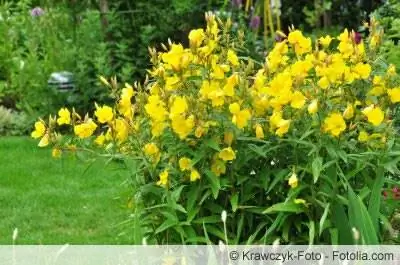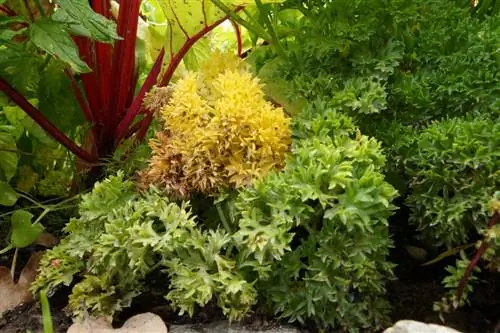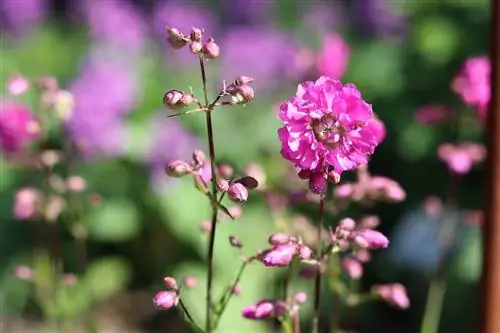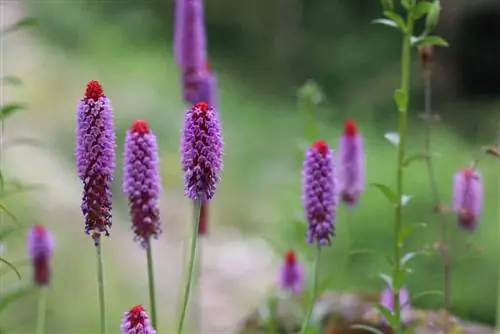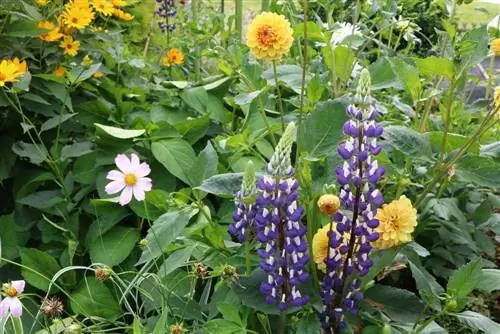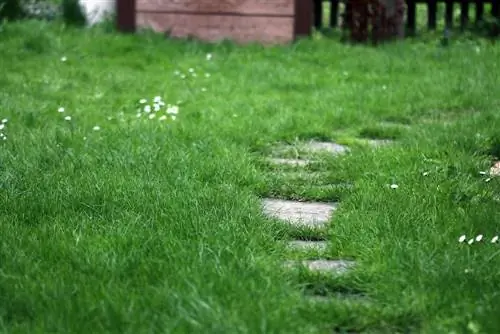- Author admin [email protected].
- Public 2023-12-17 03:39.
- Last modified 2025-06-01 06:48.
Together with the strong, sweet scent and the numerous flowers, this makes the evening primrose a very popular garden flower. In addition, the plants are extremely easy to care for and can be used in a variety of ways. Evening primroses are edible and are used in the medicine and cosmetics industry. The best known is probably evening primrose oil, which can be found in many products.
Short profile of the evening primrose
- Genus Oenothera
- Evening primrose family
- 120 to 200 species
- Come from temperate to tropical areas of America
- There are annual and biennial species, but also perennial species
- Mostly biennial, forms a rosette in the first year and flowers in the second
- Different root systems, rhizomes, taproots
- Leaves form basal rosettes or are alternate and spirally distributed along the stem
- Flowers mostly yellow, rarely white, pink to purple
- Flowers are fragrant, but usually only at night
- They are short-lived
- Capsules
Evening Primrose Care
Caring for the evening primrose is quite easy. The plants need sun and a permeable, humus-rich soil. Regular water helps it thrive, as does a dose of compost in the spring. Planting takes place in spring and cutting in autumn at the latest. It is important to remove any dead flowers. The plants usually manage to overwinter without any problems. Only a few species need extra protection. Propagation is achieved by sowing, cuttings and division. Pests and diseases are not common.
Location requirements
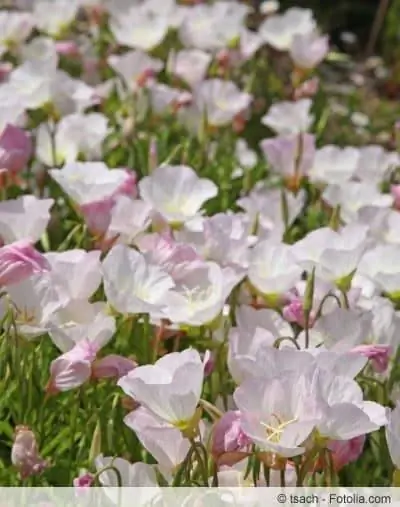
Evening primroses are found quite often in nature. They often stand on road and path embankments and also thrive on poor soil and even in quarries. The different species sometimes have quite different location requirements. Evening primroses like the sun. Although most species can cope with partial shade, they develop optimally in sunny areas. They also cope well with blazing midday sun. Before planting an evening primrose, you should know how big it will grow. There are clear differences. Large species belong in the background, small ones in the foreground. Some species tend to go wild, this should also be taken into account.
- Sunny also full sun
- Maximum partial shade
The plant substrate depends on the type of plant. There are different requirements here. However, they all like well-drained, fresh, moderately nutrient-rich and humus-rich soil. It should not be too dry and definitely not waterlogged. Some species prefer clayey soils, others prefer sandy substrates.
- For everyone - well-drained, fresh, moderately nutrient-rich, humus
- Individual species - more sandy or more loamy
Watering and fertilizing
When caring for them, it is important that evening primroses are supplied with water regularly, but never too much. The plants do not suffer from constant moisture or even wetness. When watering, the plant substrate is important. Very sandy soil that cannot retain moisture needs to be watered more frequently than clayey soil. It is important that the soil neither dries out completely nor allows water to accumulate.
- Water regularly
- Do not let it dry out or be permanently wet
You should also fertilize carefully. It is best to incorporate compost in the spring. Before and during the flowering period, regular flowering plant fertilizer can be used to replenish nutrients. However, the fertilizer should only be dosed lightly.
- Add compost in spring
- Flowering plant fertilizer in a weak dose
Plants
Oenothera is best planted in spring. Container plants can also be planted later, even in summer. Plant as deep as they were in the container.
Cutting
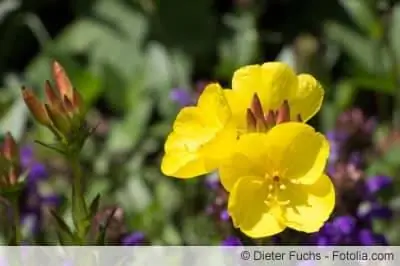
When it comes to evening primroses, it is worth removing dead parts of the plant. If the flowers are wilted, they should be cut off. This promotes further flower formation. Targeted pruning can also have a positive effect. If you cut the plant back after flowering, a second bloom can occur. Perennial species should generally be cut back after flowering or in autumn at the latest. You cut the plants about a hand's width above the ground.
- Removing faded flowers
- Cut down after flowering
Wintering
Wintering does not cause any problems. Most evening primroses are generally sufficiently hardy. For some species, however, winter protection is recommended. It is therefore important that you know the type and variety that you have brought into your garden. This way you can look up how the plants would like it to be in winter. Brushwood, which is piled up over the plants, is ideal for covering. This way they escape the weather, the ground doesn't get too wet, but enough air still gets through.
- Most species are hardy
- Cover sensitive species with brushwood
Propagation of Evening Primrose
There are several ways of propagation, depending on the type of evening primrose. They can be propagated by sowing, dividing and cuttings. The plants themselves do the rest, sowing themselves and spreading, sometimes abundantly. You can sow from spring, directly outdoors or in a container. The seeds are well covered with soil. The substrate must be kept evenly, slightly moist and should under no circumstances dry out.
- Sowing from spring to June
- Sow directly outdoors
Head cuttings are also cut in spring. The shoot tips of the plant are used. They need to be about 10cm long. The cut is made directly below a knot. The lower leaves of the cutting are removed, only 2 to 3 remain at the top. This reduces evaporation. Do not stick the shoots too tightly into the potting soil and make sure that at least one eye looks out of the soil. Since the cuttings root better in high humidity, it makes sense to cover them with a glass hood or with a plastic bag when growing in a container. New leaves indicate that rooting has been successful.
- Cut cuttings in late spring
- Let an eye look out of the earth.
Dividing evening primrose plants is very easy. First, of course, the entire plant must be lifted out of the ground. This is best done with a digging fork. It is important that the roots are not damaged. Then the soil is tapped off and the roots are divided with a sharp, clean knife. Depending on the size, the root can be divided several times. Each section requires a strong part of the root and sufficient shoots. These can then be planted again in the desired location.
Tip:
Unclean separation points and injuries to the roots can lead to rot. There is a possibility that germs can get in and cause damage. It is therefore advisable to recut any unclean areas. It also makes sense to dust the interfaces with charcoal powder. This prevents diseases and, above all, rot.
Diseases and pests
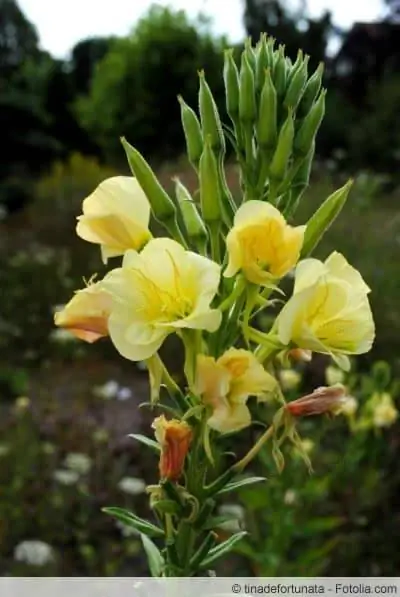
Evening primroses are actually quite robust. Nevertheless, there are diseases that threaten plants, especially fungal diseases. Theleaf spot diseaseoccurs again and again andmildew can also occur. It is always important to check on your plants regularly. The earlier diseases are detected and the sooner you take action against them, the greater the chances that the plants will soon get better again.
Leaf spot disease
Leaf spot disease involves dark leaf spots that merge into one another over time. The best thing to do here is to remove infected parts.
Cut out affected parts
Mildew
Downy mildew also occurs, the more difficult of the two most common types of mildew, because the fungus that causes it penetrates the plant tissue and does not only remain on the surface, as is the case with powdery mildew. The infestation can be recognized by a velvety, white-grey to brown coating on the underside of the leaves, by yellow or brown spots on the upper side of the leaves and by the death of infected parts of the plant. It is important to intervene quickly. The fungus spreads primarily in wet and cool weather. Agents containing neem and silicic acid that are sprayed onto the affected plants are helpful. It is important to remove affected plant parts or plants. They are not allowed in the compost!
- Mushroom sits on, under and in the leaves and shoots
- Remove affected plant parts
- Prevention with plant broths (garlic or onion broth) and by ensuring sufficient planting spacing
- Overfertilization with nitrogen can promote mildew.
Evening primrose louse
A common pest of plants is theEvening primrose louse. You can recognize it by the whitish film it leaves on the leaves. But this is washable. It makes sense here to use beneficial insects, especially parasitic wasps.
- Rinse the coating from the leaves
- Use parasitic wasps
Flea beetles also appear from time to time. This is not a flea, but a beetle that eats leaves. It can cause quite a bit of damage. Small, usually rounded holes appear, but the upper and lower leaf skin remains intact. Young, tender plants are particularly threatened by the beetle. In addition, the beetle larvae eat the roots. Even when it comes to flea beetles, prevention is better than cure. The pests like dry, warm soil. That's why regular watering, but also raking, helps. A layer of mulch should also be applied so that the soil stays moist longer. It also helps to stick matches with their sulfur heads into the soil around the plants.
- Collect beetles
- Putting matches in the ground
Conclusion
The evening primrose is an absolutely versatile plant that can be used in many different ways. Not only does it impress with its beautiful, mostly yellow flowers and its scent, but you can even eat it. Parts of the plant can also be used for medicinal or cosmetic purposes. The care is not complicated either, what more could you expect from a garden flower.

